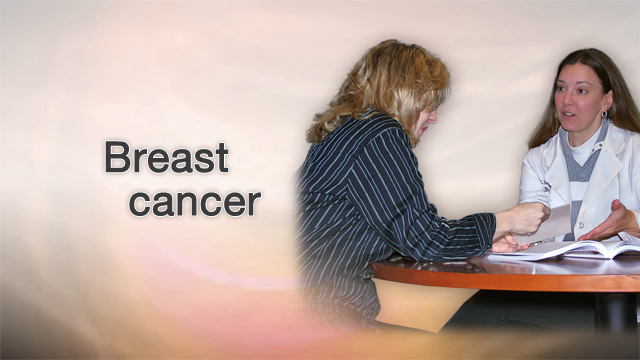Understanding your breast cancer risk
Carcinoma-lobular - risk; DCIS; LCIS - risk; Ductal carcinoma in situ - risk; Lobular carcinoma in situ - risk; Breast cancer - prevention; BRCA - breast cancer risk
Breast cancer risk factors are things that increase the chance that you could get cancer. Some risk factors you can control, such as drinking alcohol. Others, such as family history, you cannot control.
The more risk factors you have, the more your risk increases. However, it does not mean you absolutely will get cancer. Many women who get breast cancer do not have any known risk factors or a family history.

Understanding your risk factors can give you a better picture of what you can do to help prevent breast cancer.
Risk Factors You Cannot Control
Risk factors you cannot control include:
- Age. Your risk for breast cancer increases as you age. Most cancers are found in women age 55 and older.
- Gene variations. Changes in genes linked with breast cancer, such as BRCA1, BRCA2, and others increase your risk. Gene variations account for about 5% to 10% of all breast cancer cases.
- Dense breast tissue. Having more dense breast tissue and less fat breast tissue increases risk. Also, dense breast tissue can make tumors hard to see using mammography.
- Radiation exposure. Treatment involving radiation therapy to the chest wall before age 40 can increase your risk.
- Family history of breast cancer. If your mother, sister, or daughter was diagnosed with breast cancer, you have a higher risk.
- Personal history of breast cancer. If you have had breast cancer, you are at risk for another breast cancer and for your treated breast cancer coming back.
- Personal history of ovarian cancer.
- Abnormal cells found during a breast biopsy. If your breast tissue was examined in a lab and had abnormal features (but not cancer), your risk is higher.
- Reproductive and menstrual history. Getting your period before age 12, starting menopause after age 55, getting pregnant after age 30, or never getting pregnant all increase your risk.
- DES (Diethylstilbestrol). This was a medicine given to pregnant women between 1940 and 1971. Women who took DES during pregnancy to prevent miscarriage have a slightly higher risk. Women exposed to the medicine while in the womb also have a slightly higher risk.
Risk Factors You Can Control
Risk factors you can control include:
- Alcohol intake. The more alcohol you drink, the greater your risk.
- Long-term use of hormone therapy . Taking estrogen and progestin together for menopause for 5 years or more increases your risk. It is not clear if, or how much, taking birth control pills that contain estrogen increases your risk.
- Weight. Overweight women or women with obesity who have had menopause have a higher risk than women at healthy weights.
- Physical inactivity. Women who do not exercise regularly throughout life may have an increased risk.
How to Reduce Your Risk
Just because you have risk factors you cannot control does not mean you cannot take steps to lower your risk. Start by making certain lifestyle changes and working with your health care provider. Here are some things you can do to lower your risk for breast cancer:
- Maintain a healthy weight.
- Exercise at least 4 hours a week.
- Avoid alcohol, or have no more than 1 alcoholic drink in a day.
- Avoid unnecessary imaging tests, but remember that there is no proof that radiation from imaging tests increases the risk of breast cancer.
- Breastfeeding, if possible, may decrease your risk.
- Talk with your provider about the risks and benefits of taking hormone therapy. You may want to avoid taking estrogen combined with progesterone or progestin.
- If you have a family history of breast cancer, ask your provider about genetic testing.
- If you are age 35 or over, and have a high risk for breast cancer, talk to your provider about medicines to reduce breast cancer risk by blocking or reducing estrogens in the body. They include tamoxifen, raloxifene, and aromatase inhibitors.
- If you carry a harmful variant in any gene linked with breast cancer and are at very high risk, talk with your provider about preventive surgery to remove breast tissue (mastectomy).
- If you are at high risk, consider surgery to remove your ovaries. It will lower estrogen in the body and can reduce your risk for breast cancer by as much as 50%.
Some areas are unknown or not yet proven. Studies are looking at things like smoking, diet, chemicals, and types of birth control pills as potential risk factors. Talk to your provider if you are interested in joining a clinical trial for breast cancer prevention.
When to Call the Doctor
Contact your provider if:
- You have questions or concerns about your breast cancer risk.
- You are interested in genetic testing, preventive medicines, or treatments.
- You are due for a mammogram.
References
Henry NL, Shah PD, Haider I, Freer PE, Jagsi R, Sabel MS. Cancer of the breast. In: Niederhuber JE, Armitage JO, Kastan MB, Doroshow JH, Tepper JE, eds. Abeloff's Clinical Oncology. 6th ed. Philadelphia, PA: Elsevier; 2020:chap 88.
National Cancer Institute website. Breast cancer prevention (PDQ) - health professional version. www.cancer.gov/types/breast/hp/breast-prevention-pdq. Updated October 7, 2022. Accessed October 21, 2022.
US Preventive Services Task Force; Owens DK, Davidson KW, Krist AH, et al. Risk assessment, genetic counseling, and genetic testing for BRCA-related cancer: US Preventive Services Task Force Recommendation Statement. JAMA. 2019;322(7):652-665. PMID: 31429903 pubmed.ncbi.nlm.nih.gov/31429903/.
U.S. Preventive Services Task Force. Screening for breast cancer: U.S. Preventive Services Task Force final recommendation statement. www.uspreventiveservicestaskforce.org/uspstf/recommendation/breast-cancer-screening. Updated January 11, 2016. Accessed November 19, 2022.
Review Date: 9/6/2024


